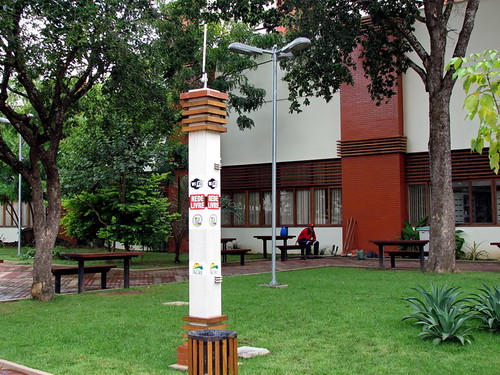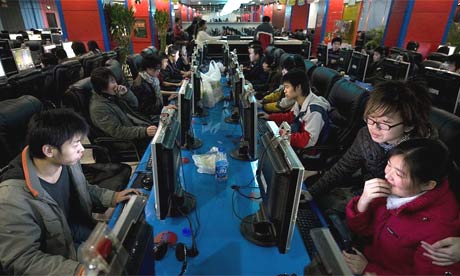
Rede Livre Free Network Wi-Fi Tower at the Public
Library in Rio Branco - Acre - Brazil
The digital revolution is exploding across South America and, like everywhere else, it's the kids who catch on first. Now, in Uruguay, there are dreams of "One Blog Per Child".
Miguel Brechner of Project Ceibal says ... By the end of the year ... 380,000 laptops will have been deployed in 2,000 schools, and that Montevideo, Uruguay will have 350 wi-fi hotspots where students can connect to the net. David Sasaki at Rising Voices has the story of what's happening in Uruguay with lots of photos and even links to the blogs of some of the kids. Here's a slideshow from it:
I can see the Internet expansion in my home region of Brazil's western Amazônia where Rio Branco's new Biblioteca Publica is loaded with computers and connections which are constantly used by all ages (and where I often go to post to this blog).
Indeed, the digital expansion knows no boundaries. Here are surfers in an Internet café in China.

Photo by Dan Chung
And here's a wonderfully inspiring story from India...
All this development is not without contradictions. According to an article in today's Guardian UK, "with more than 1.5 billion people online around the world, scientists estimate that the energy footprint of the net is growing by more than 10% each year and the Internet is heading toward being one of the largest consumers of electricity in the world. This is putting enormous pressure on the companies that provide the Internet (like Google) to find more efficient servers and new source of emissions-free energy."
That's why "power hungry" google has built its state-of-the-art server farm in The Dalles, Oregon close to the Columbia River's hydroelectric plants which supply relatively cheap and emissions-lite energy. And this means that the pressure is not only on the companies. An energy hungry world will also impact the forest and its peoples. In Amazônia, for example, hydroelectric is being touted as "clean" but it's not -- dams release a lot of the potent greenhouse gas methane, cause massive deforestation and drive indigenous peoples from their ancestral lands.
Huge dams are being planned for several areas of the Amazon basin and indigenous peoples are speaking out across the region. Enawene Nawe Indians are demanding a halt to the construction of a series of dams along the Juruena River and the Kayapo Indians continue their fierce opposition to the Belo Monte dam. Many more energy projects are planned. Two gigantic hydro projects along Madeira River in Rondonia are moving ahead and a recent accord between Brazil and Peru has announced six hydroelectric plants on Peruvian soil to supply power to Brazil.
Jose Antonio Muniz, the president of Brazil's state-owned energy giant Eletrobras, says, "Brazil needs dams if it wants to become a developed country. It is a clean form of energy." But, as every ecologist knows, "there's no such thing as a free lunch" and this seems especially apparent in our Internet-connected world where for the first time we can see the linkages.
Today, we are challenged not merely to find a form of cheap and sustainable energy for the Internet and for developing economies that depend upon it but one that includes forests, indigenous peoples and a blog for everyone.






No comments:
Post a Comment